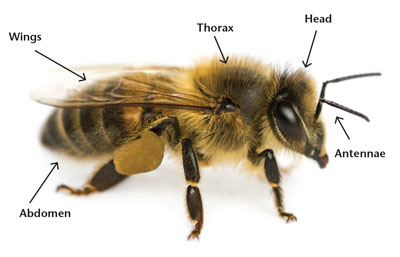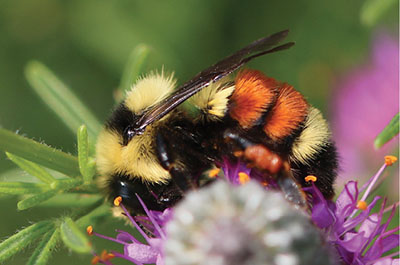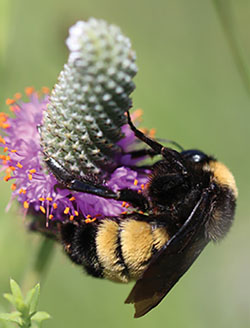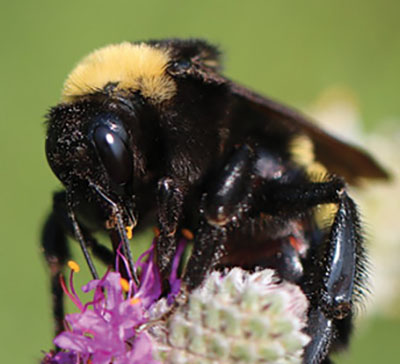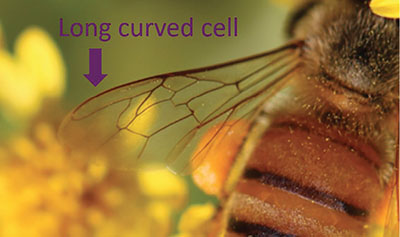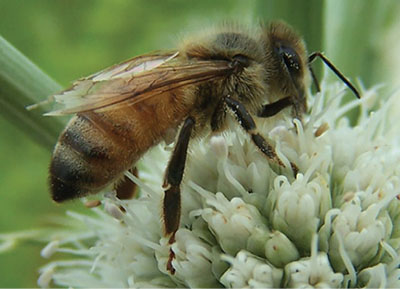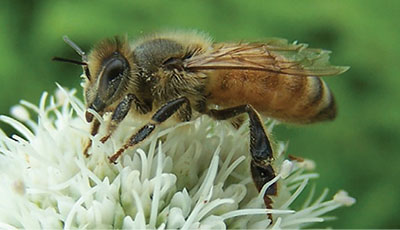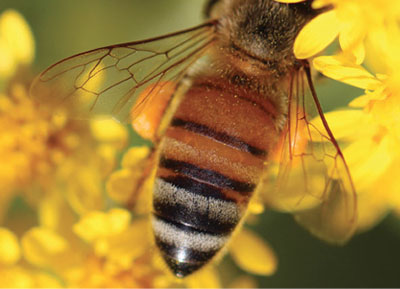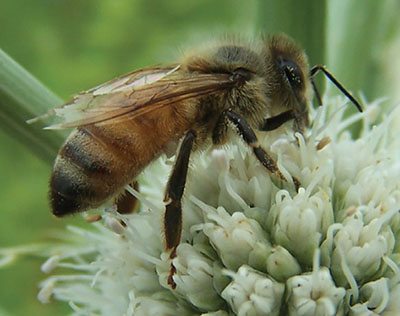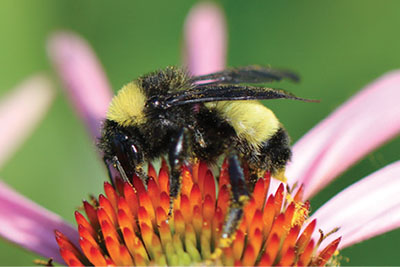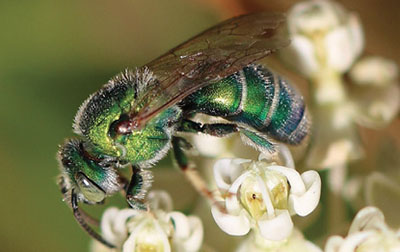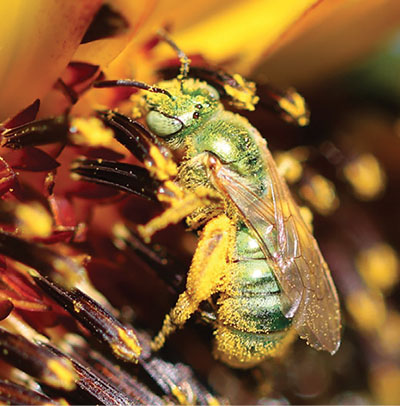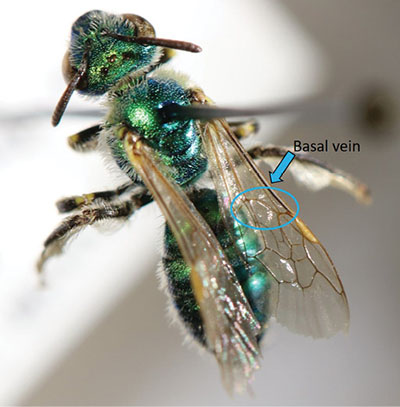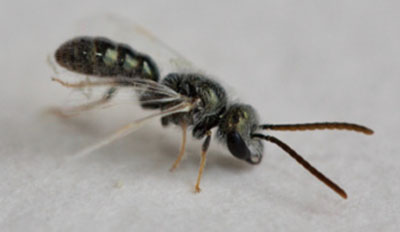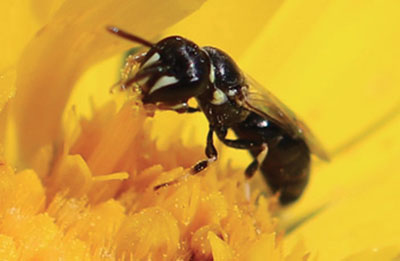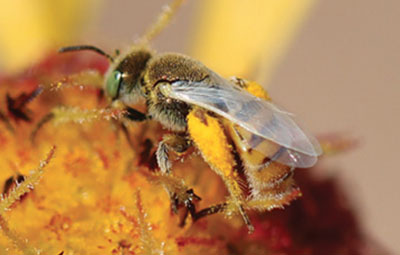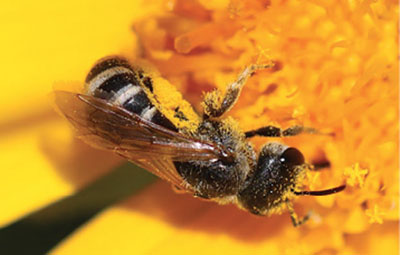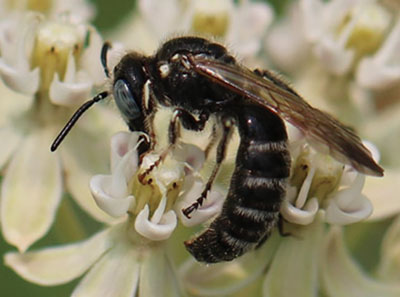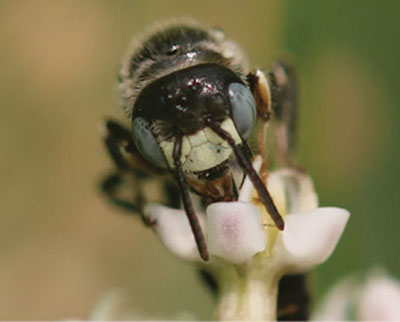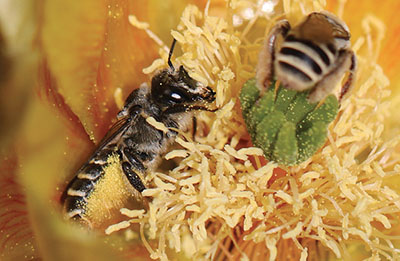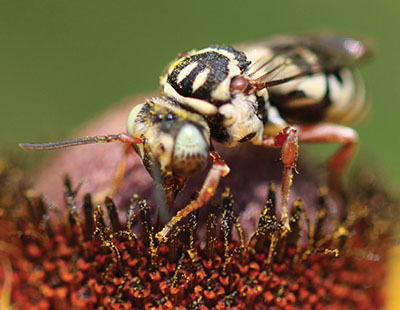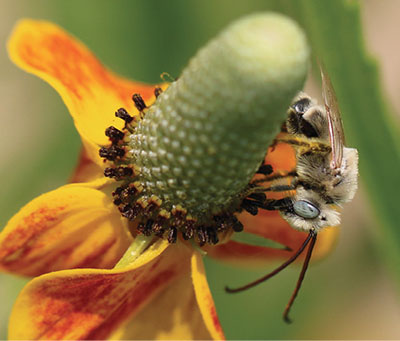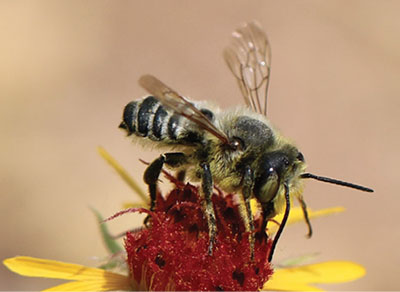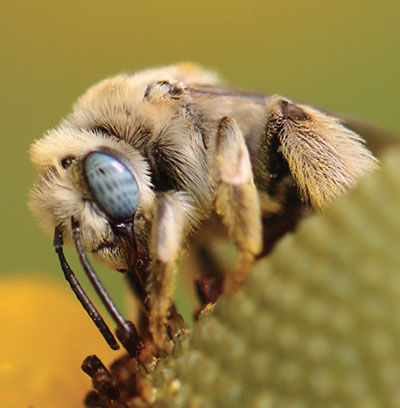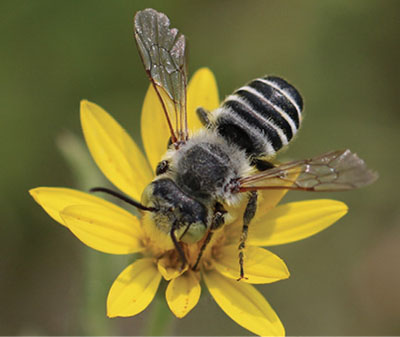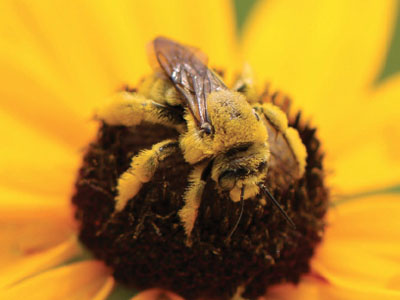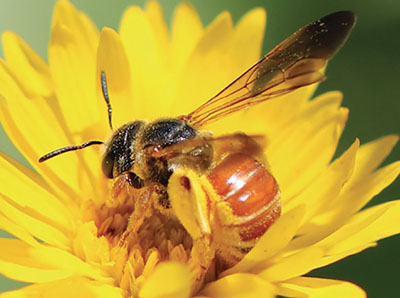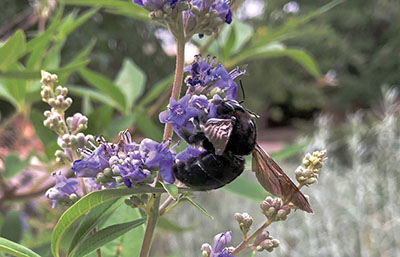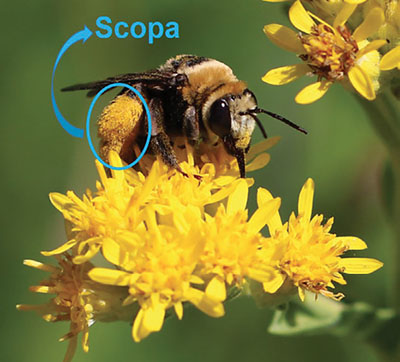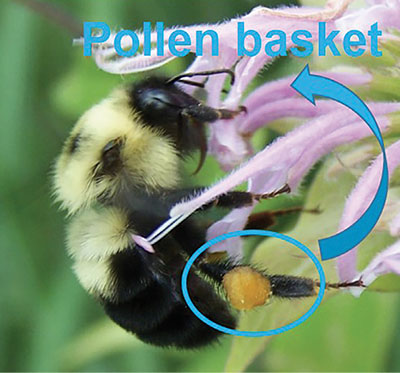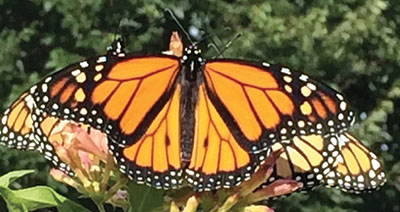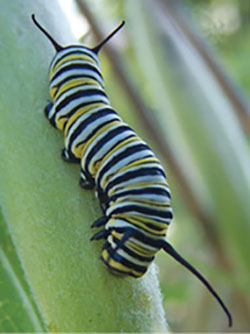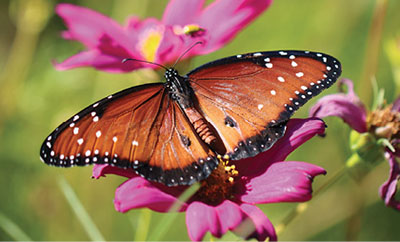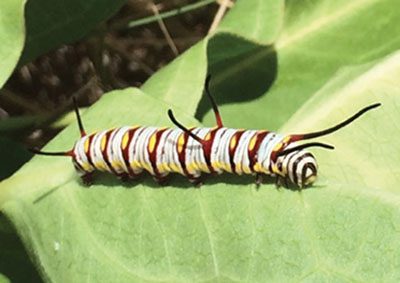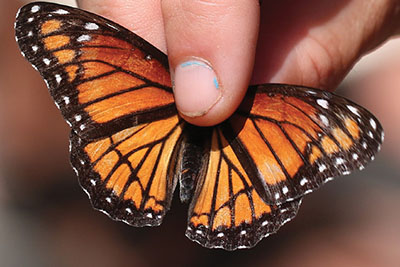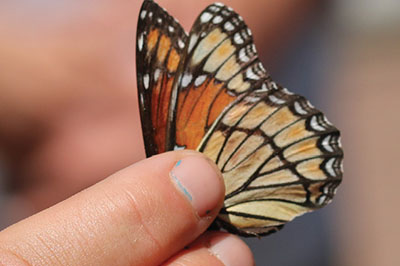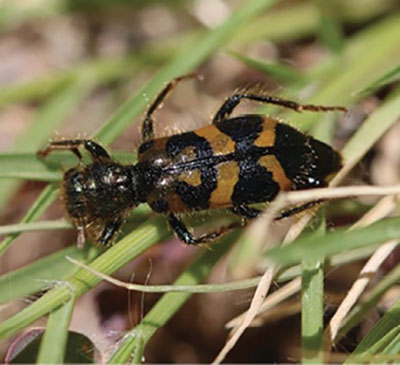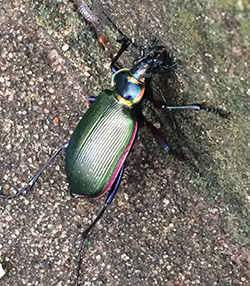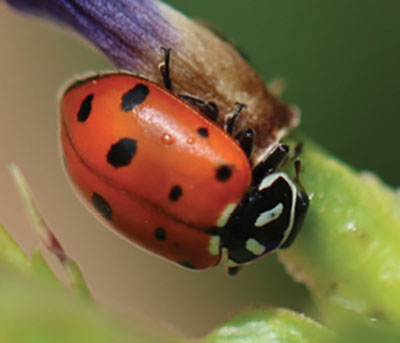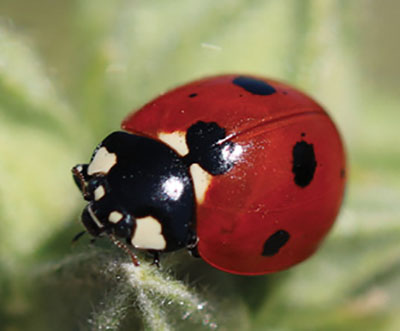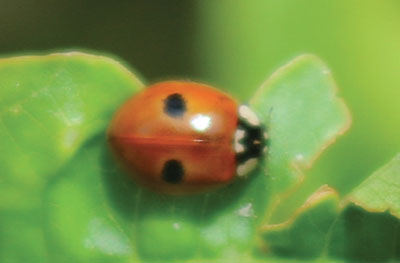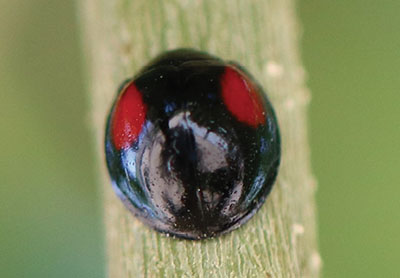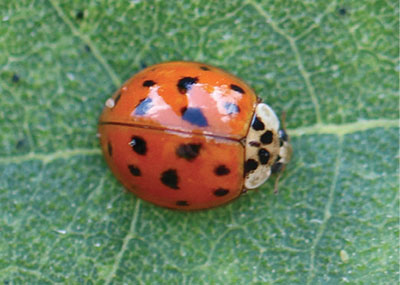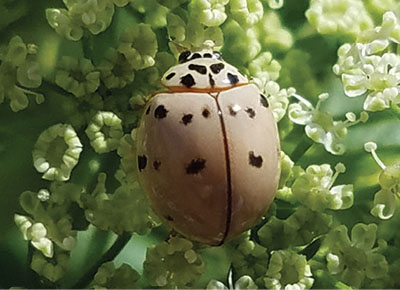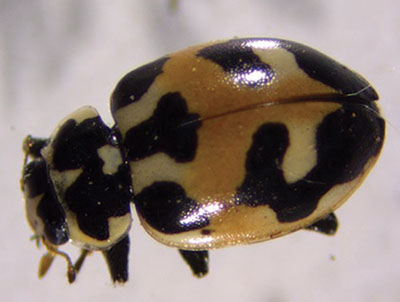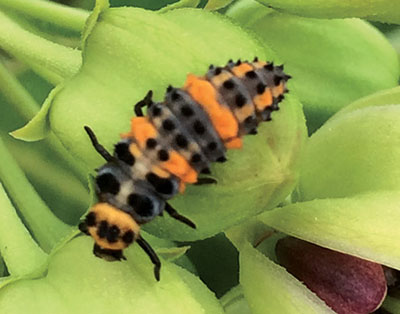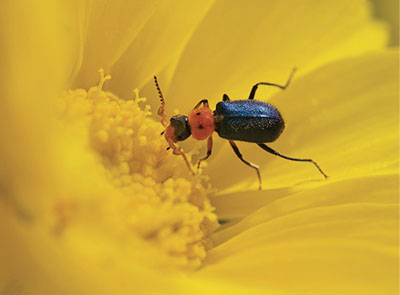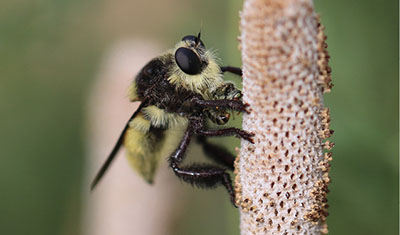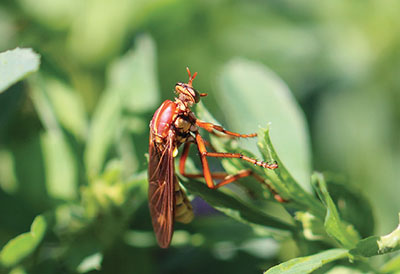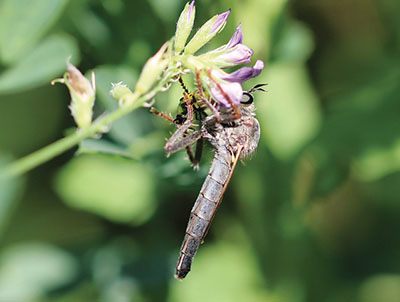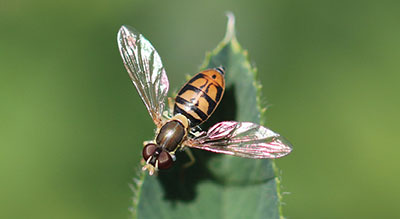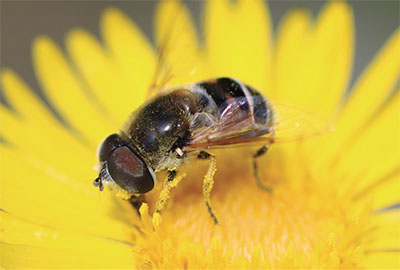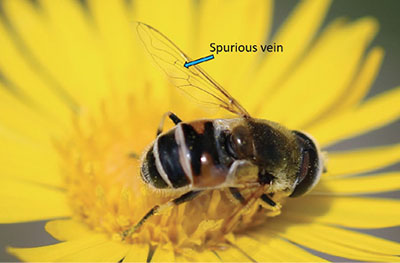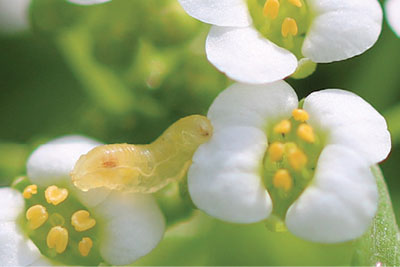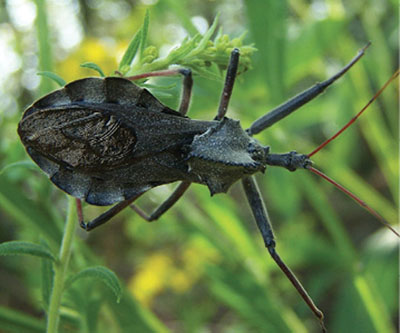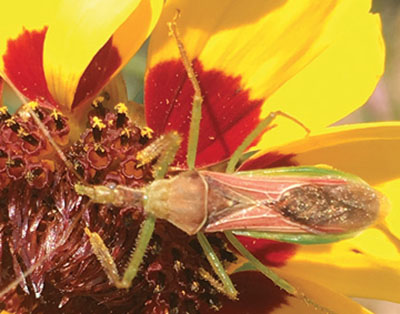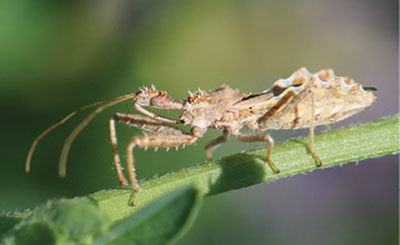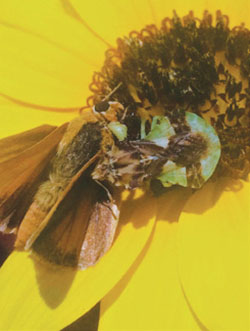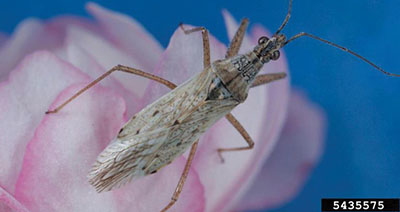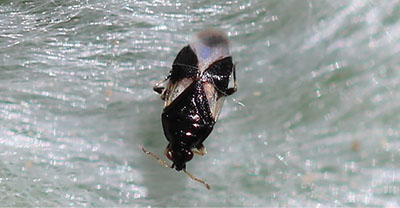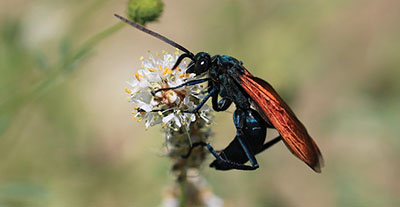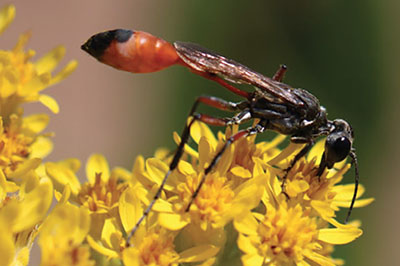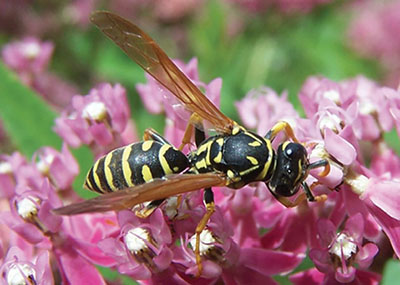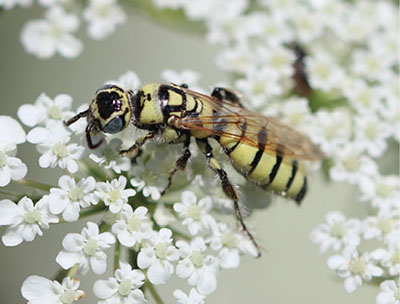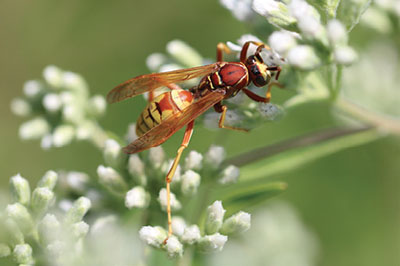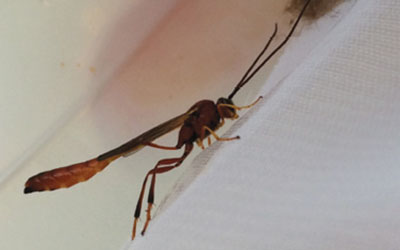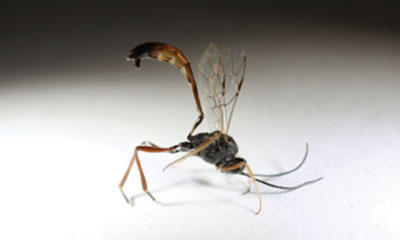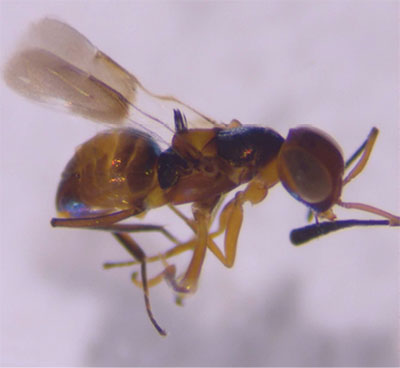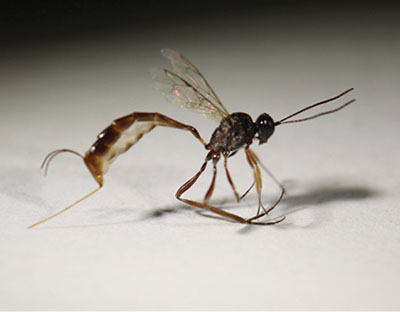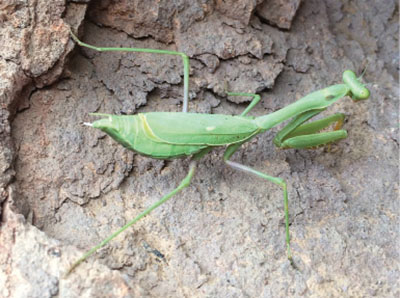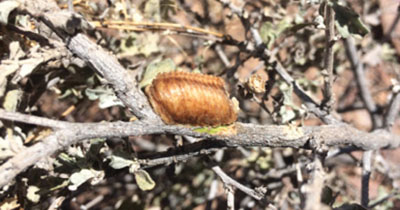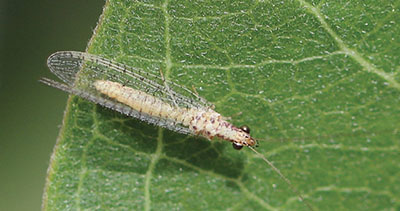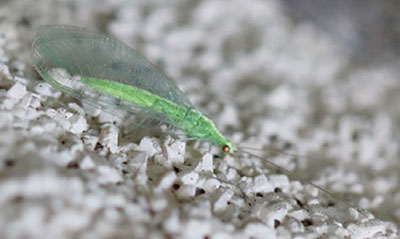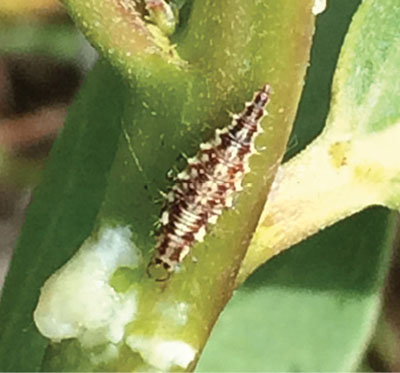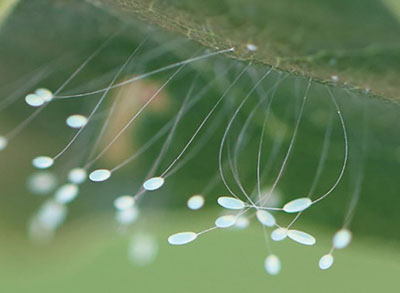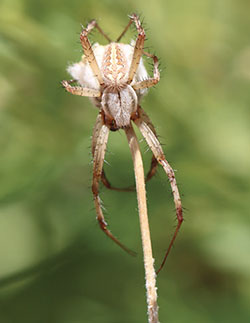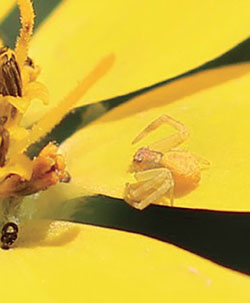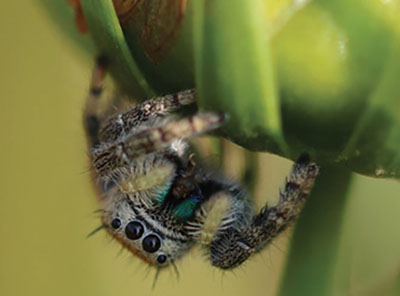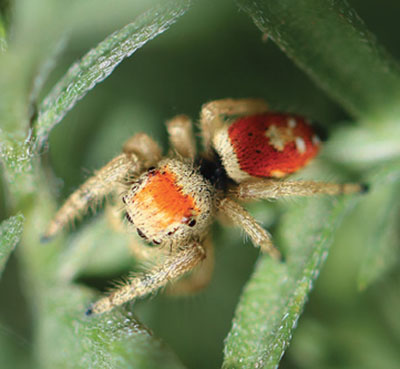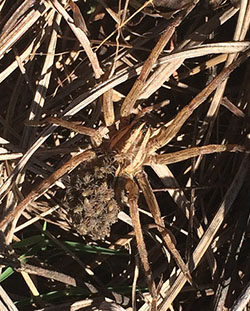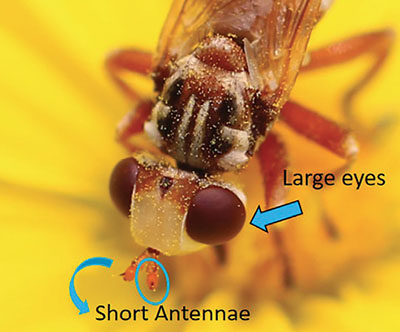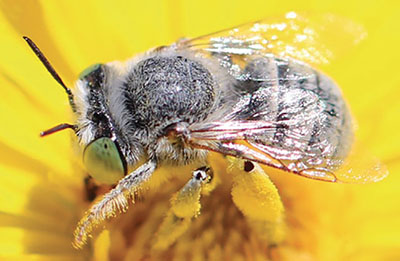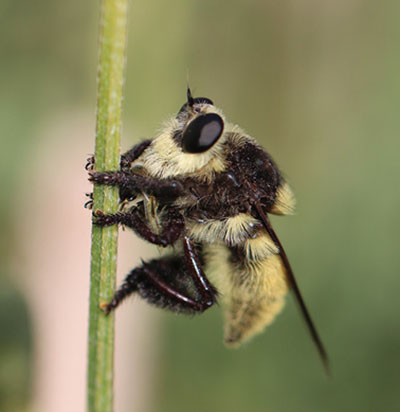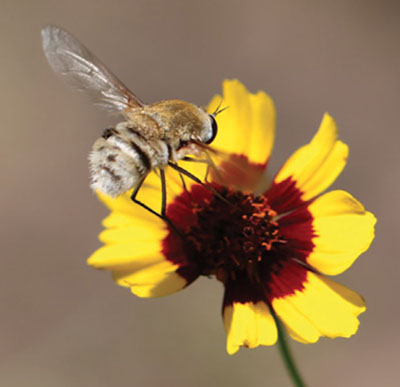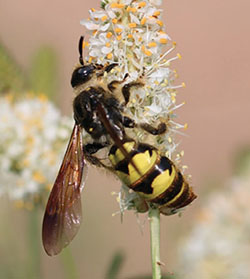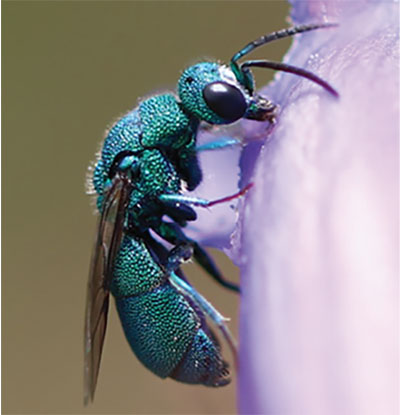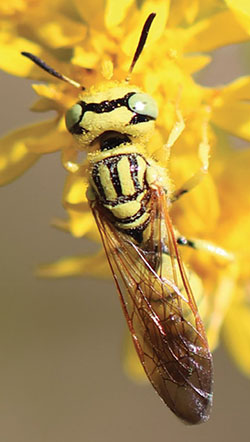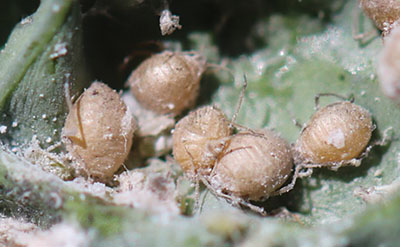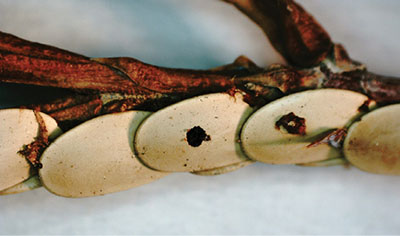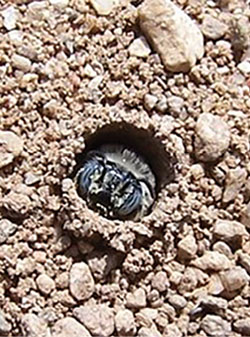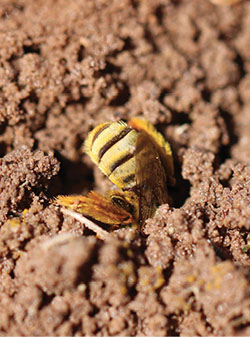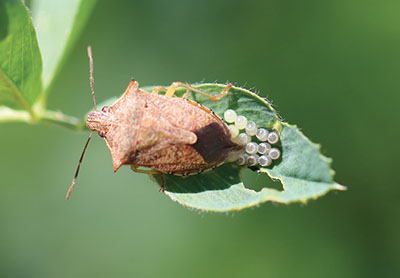Guide H-172
Ashley B. Bennett and Miranda L. Kersten
College of Agricultural, Consumer and Environmental Sciences, New Mexico State University
Authors: Respectively, former Small Urban Farm IPM Specialist, Department of Extension Plant Sciences and Senior Program Specialist, Agricultural Science Center at Los Lunas (Print Friendly PDF).
Table of Contents
Introduction
Pollinators
Natural Enemies of Pest Insects
Bee Mimic
Evidence of Beneficial Insects
Glossary
Further Reading
All photos by Ashley B. Bennett and Miranda L. Kersten unless otherwise noted.
Introduction
This guide will help you learn how to identify beneficial insects with identification tips and photos of beneficial insects found in New Mexico. Beneficial insects include pollinators and natural enemies of pest insects, which include insects that prey upon other insects and insects that parasitize other insects.
To find beneficial insects in your backyard, observe floral resources that are available. Pollinators and many natural enemies feed on pollen and nectar. Other natural enemies may lay in wait near flowers for their prey to approach. For more information on how to use floral resources to encourage populations of beneficial insects, see NMSU Extension Guide H-169, Using Insectary Plants to Attract and Sustain Beneficial Insects for Biological Pest Control (https://pubs.nmsu.edu/_h/H169).
Being able to identify beneficial insects in your backyard or garden can help you to distinguish them from pests, provide you with the knowledge to monitor beneficial insect populations in your backyard, and assist with your integrated pest management (IPM) program. For more information on this last topic, see NMSU Extension Circular 655, Integrated Pest Management (IPM) for Home Gardeners (https://pubs.nmsu.edu/_circulars/CR655).
Figure 1 shows the basic parts of an insect body. Certain terms are defined in the glossary near the end of this publication.
(Back to Table of Contents)Figure 1. Basic parts of an insect body. (Photo by © Isselee, Dreamstime.com.)
Pollinators
Bumble Bees (Figures 2A–2D)
Order: Hymenoptera
Family: Apidae
|
Identification Tips |
|
|
Head |
|
|
Body |
|
|
Wings |
2 pairs, 4 wings total |
|
Active |
Early spring (larger individuals) to late fall |
|
Other |
Generalist; visits a wide variety of flowers |
|
Key ID Tip |
Large hairy bees with typically yellow and black hair |
Figure 2A. Bumble bee.
Figure 2B. Bumble bee.
Figure 2C. Bumble bee.
Figure 2D. Bumble bee.
Honey Bees (Figures 3A–3D)
Order: Hymenoptera
Family: Apidae
|
Identification Tips |
|
|
Head |
|
|
Body |
|
|
Wings |
|
|
Active |
Generally early spring to very late fall |
|
Other |
Generalist; visits a wide variety of flowers |
|
Key ID Tip |
Hairy head and thorax; light tan to dark brown banding on abdomen |
Figure 3A. Honey bee wing showing distinct long curved cell at wing tip.
Figure 3B. Honey bee.
Figure 3C. Honey bee.
Figure 3D. The abdomen of a honey bee has short white hairs in bands and can vary from light tan to dark brown in color.
Honey Bee vs. Bumble Bee (Figures 4A and 4B)
|
Identification Tips |
|
|
Honey Bee |
Bumble Bee |
|
Medium- to large-sized bee |
Large robust bee |
|
Banded abdomen that is tan to amber |
Typically yellow and black hair patterns |
|
Abdomen less hairy than bumble bees |
Very hairy bodies, including abdomen |
|
Hairy eyes |
Banding pattern on abdomen will vary |
Figure 4A. Honey bee.
Figure 4B. Bumble bee.
Metallic Green Sweat Bees (Figures 5A–5D)
Order: Hymenoptera
Family: Halictidae
|
Identification Tips |
|
|
Head |
|
|
Body |
|
|
Wings |
|
|
Active |
Spring to fall, depending on species |
|
Other |
Generalist; visits a wide variety of flowers |
|
Key ID Tip |
Metallic green in color |
Figure 5A. Green bee with solid green abdomen.
Figure 5B. Green bee with striped abdomen.
Figure 5C. A green bee covered in pollen.
Figure 5D. The curved basal wing vein of Halictidae bees.
Small Bees (Figures 6A–6F)
Order: Hymenoptera
Families: Andrenidae, Colletidae, Halictidae
|
Identification Tips |
|
|
Head |
|
|
Body |
|
|
Wings |
2 pairs, 4 wings total |
|
Active |
Spring to fall, depending on species |
|
Other |
|
|
Key ID Tip |
Small and metallic, or small and black with yellow on face |
Figure 6A. Small bee (family Halictidae).
Figure 6B. Hylaeus (family Colletidae) bees can be distinguished by the two yellowish marking on their face.
Figure 6C. Lasioglossum sp. (family Halictidae).
Figure 6D. Halictus sp. (family Halictidae).
Figure 6E. A Hylaeus sp. nectars on a milkweed flower (Asclepias sp.).
Figure 6F. A bee from the family Andrenidae nectars on a milkweed flower.
Medium to Large Bees (Figures 7A–7I)
Order: Hymenoptera
Families: Andrenidae, Apidae, Halictidae, Megachilidae
|
Identification Tips |
|
|
Head |
|
|
Body |
|
|
Wings |
2 pairs, 4 wings total |
|
Active |
Early spring to fall, depending on species |
|
Other |
Visits disk- and tubular-shaped flowers |
|
Key ID Tip |
Pollen-carrying hairs on back legs or underside of abdomen |
Figure 7A. Megachile (family Megachilidae) bees (left) store pollen on the underside of their abdomen.
Figure 7B. This Triepeolus sp. (family Apidae) is a cleptoparasite. Look for the smiley face on the thorax to help identify this bee.
Figure 7C. A long-horned bee (family Apidae, tribe Eucerini) on a coneflower (Ratibida columnifera).
Figure 7D. A Megachile sp. (family Megachilidae) bee visits a blanketflower (Gaillardia sp.).
Figure 7E. An Anthophora sp. (family Apidae) bee visits a coneflower (Ratibida columnifera).
Figure 7F. The dorsal view of a Megachile sp. (family Megachilidae) bee.
Figure 7G. A large bee from the family Apidae covered in pollen.
Figure 7H. A Dieunomia sp. (family Halictidae) bee visits an Aster sp. flower.
Figure 7I. Carpenter bees (Xylocopa spp., family Apidae) are large bees that may be confused with bumble bees; however, carpenter bees carry pollen on scopa. (Photo by Brandt Magic.)
Large Bee vs. Bumble Bee (Figures 8A and 8B)
|
Identification Tips |
|
|
Large Bee |
Bumble Bee |
|
Pollen carried between hairs on legs (scopa) |
Pollen carried in a ball on the pollen basket |
Figure 8A. This large bee (family Apidae) carries pollen on scopa on its hind legs.
Figure 8B. Bumble bees (Bombus spp., family Apidae) carry their pollen mixed with nectar on their hind legs in a pollen basket. They do not have scopa.
Monarch Butterfly (Figures 9A–9C) and Monarch Mimics (Figures 9D–9G)
Order: Lepidoptera
Family: Nymphalidae
|
Identification Tips |
|
|
Wings |
|
|
Mimics (Figures 9D–9G) |
|
|
Active |
Summer to fall |
|
Other |
Adult monarchs visit flowers for nectar. Monarch and queen caterpillars feed only on the leaves of milkweed plants. |
|
Key ID Tips |
|
Figure 9A. A female monarch butterfly (Danaus plexippus).
Figure 9B. Male monarch butterflies can be distinguished from females by the presence of the dark gland on their hind wings.
Figure 9C. Monarch caterpillars are milkweed specialists and require milkweed plants to survive.
Figure 9D. A male queen butterfly (Danaus gilippus) nectars on a flower following its emergence from its chrysalis.
Figure 9E. Like monarchs, queen caterpillars feed only on milkweed plants. Queen caterpillars have three sets of filaments, while monarch caterpillars have only two.
Figures 9F (top) and 9G (bottom). Viceroy butterflies (Limenitis archippus) can be distinguished from monarch butterflies by the black line that runs across the lower hindwing.
Natural Enemies of Pest Insects
Checkered Beetle (Figures 10A and 10B)
Order: Coleoptera
Family: Cleridae
|
Identification Tips |
|
|
Head |
|
|
Body |
|
|
Wings |
Second pair hidden under elytra |
|
Active |
Spring to fall |
|
Prey |
Grasshopper eggs, aphids, other small insects |
|
Other |
|
|
Key ID Tips |
|
Figure 10A. Adult checkered beetles are predators, but also feed on pollen.
Figure 10B. Checkered beetle (family Cleridae).
Ground Beetle (Figure 11)
Order: Coleoptera
Family: Carabidae
|
Identification Tips |
|
|
Head |
Chewing mouthparts |
|
Body |
|
|
Wings |
Second pair hidden under elytra |
|
Active |
Summer to fall |
|
Prey |
Caterpillars, grasshoppers, beetles, aphids, flies, snails |
|
Other |
|
|
Key ID Tips |
|
Figure 11. Ground beetles (family Carabidae) may have iridescent bodies, like this fiery searcher (Calosoma scrutator), or may be dark brown or black.
Lady Beetle (Figures 12A–12H)
Order: Coleoptera
Family: Coccinellidae
|
Identification Tips |
|
|
Head |
Pronotum larger than head |
|
Body |
|
|
Wings |
Hidden under elytra |
|
Active |
Spring through fall |
|
Prey |
Aphids, scale insects, mites, thrips, insect eggs |
|
Other |
|
|
Key ID Tips |
|
Figure 12A. Convergent lady beetle (Hippodamia convergens).
Figure 12B. Seven-spotted lady beetle (Coccinella septempunctata).
Figure 12C. Two-spotted lady beetle (Adalia bipunctata).
Figure 12D. Twice-stabbed lady beetle (Chilocorus sp.).
Figure 12E. Multi-colored lady beetle (Harmonia sp.).
Figure 12F. Ashy gray lady beetle (Olla v-nigrum).
Figure 12G. Parenthesis lady beetle (Hippodamia parenthesis).
Figure 12H. Lady beetle larvae are predaceous.
Two-spotted Melyrid (Figure 13)
Order: Coleoptera
Family: Melyridae
|
Identification Tips |
|
|
Head |
Dark green |
|
Body |
|
|
Wings |
Second pair hidden under elytra |
|
Active |
Summer |
|
Prey |
Insect eggs, aphids, spider mites, caterpillars |
|
Other |
|
|
Key ID Tips |
|
Figure 13. A two-spotted melyrid (Collops bipunctatus) on a golden crownbeard (Verbesina encelioides) flower. (Photo by Pamela Wolfe.)
Robber Fly (Figures 14A–14C)
Order: Diptera
Family: Asilidae
|
Identification Tips |
|
|
Head |
|
|
Body |
|
|
Wings |
1 pair, 2 wings total |
|
Active |
Summer |
|
Prey |
Butterflies, bees, beetles, grasshoppers, leafhoppers, wasps, flies, spiders |
|
Other |
|
|
Key ID Tip |
Large eyes, single pair of wings, long tapering abdomen, long legs |
Figure 14A. A bee-mimicking robber fly (Mallophora fautrix) with its bee prey.
Figure 14B. A robber fly perches on a plant.
Figure 14C. A robber fly showing the tapered abdomen.
Syrphid Fly (Figures 15A–15D)
Order: Diptera
Family: Syrphidae
|
Identification Tips |
|
|
Head |
Large eyes with short antennae |
|
Body |
|
|
Wings |
|
|
Active |
Spring through fall |
|
Prey |
Aphids, scale insects, spider mites, thrips |
|
Other |
|
|
Key ID Tip |
Only have two wings, large eyes, short antenna, are yellow and black in color and often have an iridescent sheen to wings, often seen hovering over plants |
Figure 15A. Syrphid flies often have an iridescent sheen on wings, black and yellow coloring on abdomen, and large eyes.
Figure 15B. Syrphid flies have large eyes and short antennae.
Figure 15C. The spurious vein in the wing may be visible in larger syrphid flies.
Figure 15D. A syrphid fly larva crawls between two alyssum (Lobularia maritima) flowers.
Tachinid Fly (Figure 16)
Order: Diptera
Family: Tachinidae
|
Identification Tips |
|
|
Head |
|
|
Body |
|
|
Wings |
1 pair, 2 wings total |
|
Active |
Spring through fall |
|
Prey/Host |
Mostly caterpillars, but may also target beetles, grasshoppers, and other insects |
|
Other |
|
|
Key ID Tip |
Resembles a housefly but has more hairs that are thick and bristled |
Figure 16. Tachinid fly (left) and pupal case.
Assassin and Ambush Bugs (Figures 17A–17E)
Order: Hemiptera
Family: Reduviidae
|
Identification Tips |
|
|
Head |
|
|
Body |
|
|
Wings |
2 pairs that are membranous with clear tips |
|
Active |
Summer |
|
Prey |
Aphids, caterpillars, grasshoppers, beetles |
|
Other |
|
|
Key ID Tips |
|
Figure 17A. A wheel bug sits on a flower. Its beak (mouthpart on an assassin bug) can be seen folded under its head.
Figure 17B. A wheel bug sitting on goldenrod (Solidago sp.) shows the wings folded on the wider abdomen.
Figure 17C. A leafhopper assassin bug lays in wait for prey on a plains coreopsis (Coreopsis tinctoria) flower.
Figure 17D. The side view of this assassin bug shows the spines on the legs, long beak, and neck.
Figure 17E. An ambush bug feeds on a skipper butterfly (family Hesperiidae).
Beetles vs. True Bugs
|
Identification Tips |
|
|
Beetles (family Coleoptera) |
True Bugs (family Hemiptera) |
|
Chewing mouthparts |
Piercing–sucking mouthparts |
|
Elytra covering second set of wings |
Membranous wing tips |
|
Complete metamorphosis |
Incomplete metamorphosis |
Damsel Bug (Figure 18)
Order: Hemiptera
Family: Nabidae
|
Identification Tips |
|
|
Head |
Piercing–sucking mouthparts called a beak |
|
Body |
|
|
Wings |
2 pairs, longer than body, brown or tan in color |
|
Active |
Summer to fall |
|
Prey |
Aphids, small caterpillars, thrips, mites, leafhoppers, leaf beetles, insect eggs |
|
Other |
|
|
Key ID Tips |
|
Figure 18. A common damsel bug (Nabis americoferus). (Photo by Joseph Berger, Bugwood.org.)
Minute Pirate Bug (Figure 19)
Order: Hemiptera
Family: Anthocoridae
|
Identification Tips |
|
|
Head |
|
|
Body |
|
|
Wings |
|
|
Active |
Late spring to summer |
|
Prey |
Thrips, mites, scale insects, aphids, small caterpillars, insect eggs |
|
Other |
|
|
Key ID Tips |
|
Figure 19. Minute pirate bugs (Orius spp.) can be difficult to see due to their small size.
Wasp—Large (Figures 20A–20G)
Order: Hymenoptera
Families: Crabronidae, Pompilidae, Scoliidae, Sphecidae, Vespidae
|
Identification Tips |
|
|
Head |
|
|
Body |
|
|
Wings |
|
|
Active |
Spring to fall |
|
Prey |
Wide variety of insects and spiders |
|
Other |
Adults and immatures are predaceous; adult wasps will also feed on nectar |
|
Key ID Tips |
|
Figure 20A. Large wasp (family Pompilidae).
Figure 20B. Large wasp (family Sphecidae).
Figure 20C. Large wasp (family Sphecidae).
Figure 20D. Large wasp (family Vespidae).
Figure 20E. Large wasp (family Scoliidae).
Figure 20F. Large wasp (family Scoliidae).
Figure 20G. Large wasp (family Vespidae).
Wasp—Small (Figures 21A–21E)
Order: Hymenoptera
Superfamilies: Chalcidoidea, Cynipoidea, Ichneumonoidea
|
Identification Tips |
|
|
Head |
Segmented antennae with moderate-sized eyes |
|
Body |
|
|
Wings |
2 pairs, 4 wings total |
|
Active |
Summer |
|
Prey |
|
|
Other |
Adults visit flowers, while immatures are predaceous on hosts (parasitoid) |
|
Key ID Tip |
Often very small, not hairy, long antennae |
Figure 21A. Small wasp (family Ichneumonidae, superfamily Ichneumonoidea).
Figure 21B. Small wasp (family Ichneumonidae, superfamily Ichneumonoidea).
Figure 21C. Small wasp (family Encyrtidae, superfamily Chalcidoidea).
Figure 21D. Small wasp (family Eucoilidae, superfamily Cynipoidea).
Figure 21E. Small wasp (family Ichneumonidae, superfamily Ichneumonoidea).
Praying Mantis (Figures 22A and 22B)
Order: Mantodea
Family: Mantidae
|
Identification Tips |
|
|
Head |
Triangular head with very large eyes |
|
Body |
|
|
Wings |
2 pairs, 4 wings total |
|
Active |
Summer |
|
Prey |
Aphids, grasshoppers, beetles, bees, wasps, true bugs, butterflies, moths, caterpillars, flies |
|
Other |
|
|
Key ID Tip |
Large size, triangular head with large eyes, elongated pronotum (segment with first pair of legs), spiny raptorial front legs |
Figure 22A. Notice the wings are not fully developed on this mantis, indicating that it is not yet an adult but an immature.
Figure 22B. A praying mantis egg case laid on a branch.
Green Lacewing (Figures 23A–23D)
Order: Neuroptera
Family: Chrysopidae
|
Identification Tips |
|
|
Head |
|
|
Body |
|
|
Wings |
|
|
Active |
Spring to summer |
|
Prey |
Aphids, small caterpillars, thrips, mites, whiteflies, mealybugs, soft-bodied insects |
|
Other |
|
|
Key ID Tip |
Wings have many veins and fold roof-like over the abdomen |
Figure 23A. Green lacewing adult showing long lacy wings.
Figure 23B. Green lacewing adult.
Figure 23C. Immature lacewing.
Figure 23D. Lacewing eggs hang from the underside of a leaf.
Spider (Figures 24A-24E)
Order: Araneae
Families: Araneidae, Lycosidae, Salticidae, Thomisidae
|
Identification Tips |
|
|
Head |
Small head compared to body, usually with eight eyes |
|
Body |
Oval-shaped body with eight legs |
|
Active |
Summer |
|
Prey |
Beetles, caterpillars, aphids, bees, wasps, butterflies |
|
Other |
|
|
Key ID Tips |
|
Figure 24A. Orb weaver spider (family Araneidae).
Figure 24B. Crab spider (family Thomisidae).
Figure 24C. Jumping spiders (family Salticidae) have two large eyes in the bottom center of their heads.
Figure 24D. Jumping spider (family Salticidae).
Figure 24E. A wolf spider (family Lycosidae) carries its young on its abdomen.
Bee Mimics
Many species of flies and wasps may appear visually similar to bees. Here are some quick tips to tell them apart as well as some examples of bee mimics.
Bee vs. Fly (Figures 25A–25E)
|
Key ID |
Bee |
Fly |
|
Large eyes, often touching on top |
No |
Yes |
|
Short stubby antennae |
No |
Yes |
|
Only 2 wings |
No |
Yes |
|
Carries pollen |
Yes |
No |
Figure 25A. Flies have large eyes and short antennae.
Figure 25B. Bees have longer antennae and carry pollen on their body.
Figure 25C. A bee-mimicking robber fly rests on a plant stem. Notice the “beard” on its face.
Figure 25D. Bee flies (family Bombyliidae) may be pollinators and look like bees, but their larval stage is actually a predator and parasitoid of bees.
Figure 25E. Syrphid flies mimic bees to try to avoid predation.
Bee vs. Wasp (Figures 26A–26C)
|
Key ID |
Bee |
Wasp |
|
Generally more coloration |
No |
Yes |
|
Hairy body |
Yes |
No |
|
Longer body shape |
No |
Yes |
|
Long slender hairless legs |
No |
Yes |
|
Carries pollen |
Yes |
No |
Figure 26A. Wasp (family Scoliidae).
Figure 26B. Wasp (family Chrysididae).
Figure 26C. Wasp (family Crabronidae).
Evidence Of Beneficial Insects
In your landscape, you may not always see beneficial insects themselves, but you can look for evidence of their activity. Figures 27A through 27F show some examples of the evidence beneficial insects can leave behind.
Figure 27A. Aphid “mummies,” or aphids that have been parasitized by beneficial insects, appear gray and swollen.
Figure 27B. Parasitoid wasps leave exit holes in eggs following their emergence. This evidence may require a hand lens or microscope to view. (Photo by Pamela Wolfe.)
Figure 27C. The presence of leafcutter bees (family Megachilidae) may be confirmed by looking for the “C” shaped damage they cause to leaves. Female leafcutter bees remove pieces from leaves to use as nesting materials.
Figures 27D (top) and 27E (bottom). Check areas of bare ground for the entry holes created by ground nesting bees.
Figure 27F. Check plant material for insect eggs. Eggs may be laid singly, in rows, or in clusters, depending on the species.
Glossary
Abdomen: The body section of an insect that is connected to the back of the thorax and contains reproductive and digestive organs.
Beak: The piercing–sucking mouthpart found on true bugs (order Hemiptera).
Beneficial insect: An insect that provides a service, such as pollination of flowers or predation of pests.
Elytra: Hard protective covering (modified front wings) over hind wings found on beetles (order Coleoptera).
Forewing: One of the front wings of an insect with four wings.
Hindwing: One of the back wings of an insect with four wings.
Integrated pest management (IPM): A pest management approach that combines cultural, mechanical, chemical, and biological control strategies.
Natural enemies: Organisms that reduce populations of another organism through predation and parasitism.
Overwinter: How an insect passes the winter season.
Parasitoid: An insect with a free-living adult stage and a parasitic larval stage.
Predator: An insect that preys on other insects.
Pronotum: The cover of the prothorax (the first segment of the thorax).
Scopa: Hairs on the legs of some bees that collect pollen.
Thorax: The middle body section of an insect that is found between the head and the abdomen. Legs and wings are attached to this section.
Further Reading
For more information about beneficial insects and their conservation, visit these resources.
Bennett, A.B. 2018. Using insectary plants to attract and sustain beneficial insects for biological pest control [Guide H-169; online]. Las Cruces: New Mexico State University Cooperative Extension Service. https://pubs.nmsu.edu/_h/H169/
Brown, L.M., P.C. Ellsworth, G.B. Hughes, S. Bundy, P. Porter, V.M. Barlow, S.E. Naranjo, D. Kerns, A. Mustafa, and A. Fournier. 2013. Natural enemies of the Southwest: A field guide to the arthropod natural enemies of Southwestern field crops. Tucson: The University of Arizona.
Flint, M.L., and S.H. Dreistadt. 1998. Natural enemies handbook: The illustrated guide
to biological pest control. Berkeley: University of California Press.
Gardiner, M.M. 2015. Good garden bugs: Everything you need to know about predatory beneficial insects. Bloomington, IN: Quarry Books.
Grasswitz, T.R., and D.R. Dreesen. 2012. Pocket guide to the beneficial insects of New Mexico [Online]. Las Cruces: New Mexico State University Cooperative Extension Service. https://aces.nmsu.edu/pubs/insects/docs/Beneficial_Insects.pdf
Grasswitz, T.R., and D.R. Dreesen. 2012. Pocket guide to the native bees of New Mexico [Online]. Las Cruces: New Mexico State University Cooperative Extension Service. https://aces.nmsu.edu/pubs/bees/docs/BeeGuide.pdf
Grissell, E. 2010. Bees, wasps, and ants: The indispensable role of Hymenoptera in gardens. Portland, OR: Timber Press.
Holm. H. 2017. Bees: An identification and native plant forage guide. Minnetonka, MN: Pollination Press LLC.
Hopwood, J., E. Lee-Mäder, L. Morandin, M. Vaughan, C. Kremen, J.K. Cruz, J. Eckberg, S.F. Jordan, K. Gill, T. Heidel-Baker, and S. Morris. 2016. Habitat planning for beneficial insects: Guidelines for conservation biological control [Online]. Portland, OR: The Xerces Society for Invertebrate Conservation. http://xerces.org/habitat-planning-for-beneficial-insects/
Mader, E., M. Shepherd, M. Vaughan, S.H. Black, and G. LeBuhn. 2011. Attracting native pollinators: Protecting North America’s bees and butterflies. North Adams, MA: Storey Publishing.
Mahr, D.L., P. Whitaker, and N. Ridgway. 2008. Biological control of insects and mites: An introduction to beneficial natural enemies and their use in pest management. Madison: University of Wisconsin-Extension.
Walliser, J. 2013. Attracting beneficial bugs to your garden: A natural approach to pest control. Portland, OR: Timber Press.
Wilson, J.S., and O.J. Messinger Carril. 2016. The bees in your backyard: A guide to North America’s bees. Princeton, NJ: Princeton University Press.
Additional Extension Resources
H-110: Backyard Composting
https://pubs.nmsu.edu/_h/H110/
H-169: Using Insectary Plants to Attract and Sustain Beneficial Insects for Biological Pest Control
https://pubs.nmsu.edu/_h/H169/
CR-655: Integrated Pest Management (IPM) for Home Gardeners
https://pubs.nmsu.edu/_circulars/CR655/
This work is supported by the Crop Protection and Pest Management Program (grant no. 2017-70006-27189) and by the Agriculture and Food Research Initiative Cooperative Agricultural Project (grant no. 2015-68004-23179/subaward no: 2015-0097-25) from the National Institute of Food and Agriculture.
To find more resources for your business, home, or family, visit the College of Agricultural, Consumer and Environmental Sciences on the World Wide Web at pubs.nmsu.edu
Contents of publications may be freely reproduced for educational purposes. All other rights reserved. For permission to use publications for other purposes, contact pubs@nmsu.edu or the authors listed on the publication.
New Mexico State University is an equal opportunity/affirmative action employer and educator.
NMSU and the U.S. Department of Agriculture cooperating.
May 2019, Las Cruces, NM


